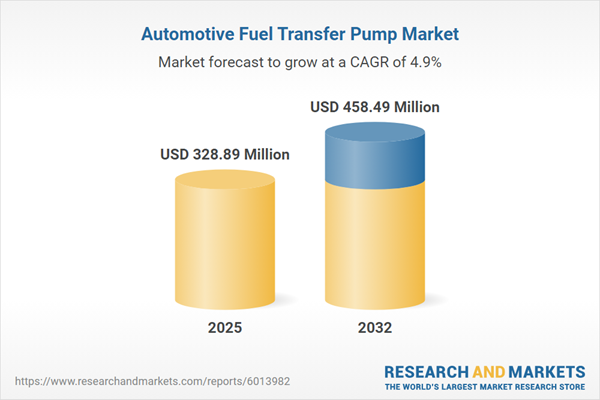Speak directly to the analyst to clarify any post sales queries you may have.
The automotive fuel transfer pump market is experiencing rapid transformation as new technologies, alternative fuels, and regulatory shifts redefine industry benchmarks. Senior leaders must proactively adapt to regulatory pressures and evolving fleet strategies to maintain an edge in this competitive market landscape.
Market Snapshot: Global Automotive Fuel Transfer Pump Market Growth and Outlook
The global automotive fuel transfer pump market is poised for steady expansion, with projections showing growth from USD 313.29 million in 2024 to USD 328.89 million in 2025, ultimately reaching USD 458.49 million by 2032. This represents a compound annual growth rate (CAGR) of 4.87%. Market dynamics are being shaped by regulatory advancements, increased digitalization in fuel pump design, and rising demand for alternative fuel-compatible systems. Companies across the sector are investing in digitized controls, leveraging technology to optimize fleet management, and deepening supplier collaboration—all supporting the shift toward electrified vehicles and more sophisticated automotive platforms.
Scope & Segmentation: Automotive Fuel Transfer Pump Market
- Application Segments: Commercial vehicles demand robust and adaptable pump solutions to withstand intense duty cycles, while passenger cars and off-highway equipment rely on integrated, space-efficient pump designs for targeted operational needs.
- Pump Types: Mechanical pump variants maintain relevance in established models, offering dependable performance, whereas electric pumps deliver improved energy efficiency and seamless compatibility with modern fuel management systems.
- Fuel Types: Adoption of fuel transfer pumps suitable for compressed natural gas (CNG), hydrogen, and liquefied petroleum gas (LPG) supports emissions reduction strategies. Gasoline and diesel pumps remain crucial for fleets in transitional phases.
- End Uses: Heavy-duty fleet operators require durable, reliability-focused pump solutions, while original equipment manufacturers (OEMs) look for adaptable, advanced systems that fit compact cabin layouts and evolving integration needs.
- Sales Channels: OEM channels focus on technical compliance and smooth vehicle integration, whereas aftermarket sales highlight flexible replacement options catering to a wide array of vehicle types and legacy models.
- Regional Markets: Product strategies differ by geography, with variable compliance landscapes and consumer demands across the Americas, Europe, the Middle East and Africa, and Asia-Pacific, prompting region-specific business approaches.
- Key Players Profiled: Leading companies include Robert Bosch GmbH, DENSO Corporation, Continental AG, TI Fluid Systems UK Limited, Aptiv PLC, BorgWarner Inc., Walbro LLC, ITT Inc., Great Plains Industries, Inc., and Carter Fuel Systems, LLC.
Key Takeaways: Strategic Insights for Senior Decision-Makers
- Digital integration in fuel transfer pump systems enables predictive maintenance and fortifies fleet responsiveness to changing demands, supporting operational excellence across varied asset portfolios.
- Incorporation of modular designs, variable-speed controls, and advanced composite materials enhances adaptability to emerging vehicle powertrain architectures and future electrification requirements.
- Demand is rising for pump assemblies that balance performance with compactness, fulfilling the industry’s high standards for efficiency and meeting the challenges of reducing available cabin space.
- Regionalized sourcing tactics and agile supply chains reduce exposure to compliance volatility and supply disruptions, enhancing operational continuity.
- OEM and aftermarket segments require clear distinction in product approach; while OEMs stress advanced system integration, aftermarket solutions focus on compatibility and ease of retrofit for legacy fleets.
- Innovations in materials and control electronics reinforce regulatory compliance while supporting the transition to more intricate, technologically advanced vehicle designs.
Tariff Impact: Navigating US Market Policy Shifts
Upcoming US tariff revisions for 2025 are motivating manufacturers to reengineer supply chains, emphasizing local and regional sourcing to ensure business continuity. Flexibility in selecting materials and scaling sourcing capabilities is now essential for organizational resilience amidst ongoing policy changes.
Methodology & Data Sources
This analysis draws on in-depth interviews with automotive engineers, procurement executives, and technical experts, supported by secondary research, patent intelligence, and policy reviews. The combined approach assures an accurate picture of current trends, adoption rates, and compliance landscape within the automotive fuel transfer pump market.
Why This Report Matters
- Comprehensive segmentation and trend examination empower executives to align resource allocation and development focus with prevailing market direction.
- Thorough evaluation of supply chain and regulatory influences strengthens risk management and informs sound procurement and capital decisions.
- Unified insights into innovation, regional differences, and market entry routes support targeted investments and fuel effective collaboration between OEMs and aftermarket partners.
Conclusion
Sustained growth in the automotive fuel transfer pump market will rely on adaptable leadership and an early focus on technological and regulatory changes. Organizations prioritizing innovation and responsive strategy stand to maximize gains in this evolving sector.
Additional Product Information:
- Purchase of this report includes 1 year online access with quarterly updates.
- This report can be updated on request. Please contact our Customer Experience team using the Ask a Question widget on our website.
Table of Contents
3. Executive Summary
4. Market Overview
7. Cumulative Impact of Artificial Intelligence 2025
Companies Mentioned
The companies profiled in this Automotive Fuel Transfer Pump market report include:- Robert Bosch GmbH
- DENSO Corporation
- Continental AG
- TI Fluid Systems UK Limited
- Aptiv PLC
- BorgWarner Inc.
- Walbro LLC
- ITT Inc.
- Great Plains Industries, Inc.
- Carter Fuel Systems, LLC
Table Information
| Report Attribute | Details |
|---|---|
| No. of Pages | 184 |
| Published | October 2025 |
| Forecast Period | 2025 - 2032 |
| Estimated Market Value ( USD | $ 328.89 Million |
| Forecasted Market Value ( USD | $ 458.49 Million |
| Compound Annual Growth Rate | 4.8% |
| Regions Covered | Global |
| No. of Companies Mentioned | 11 |









